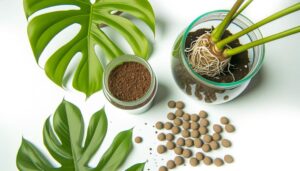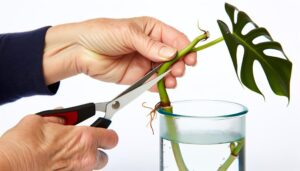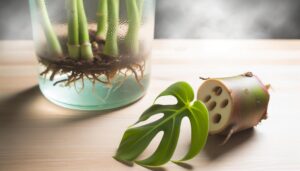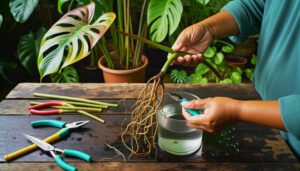How to Prune and Propagate Monstera: A Comprehensive Guide!
To prune and propagate Monstera, start in early spring or summer. Use sterilized pruning shears to cut above a node at a 45-degree angle.
Use the trimmings for propagation by confirming they have a node and aerial root. Place in water or well-draining soil until roots develop.
Maintain high humidity and bright, indirect light. Keep the soil moist but not waterlogged, and fertilize monthly with a water-soluble fertilizer.
These steps guarantee healthy, vigorous growth. You’ll find there’s more to mastering the care and propagation of your Monstera by exploring advanced techniques and tips.
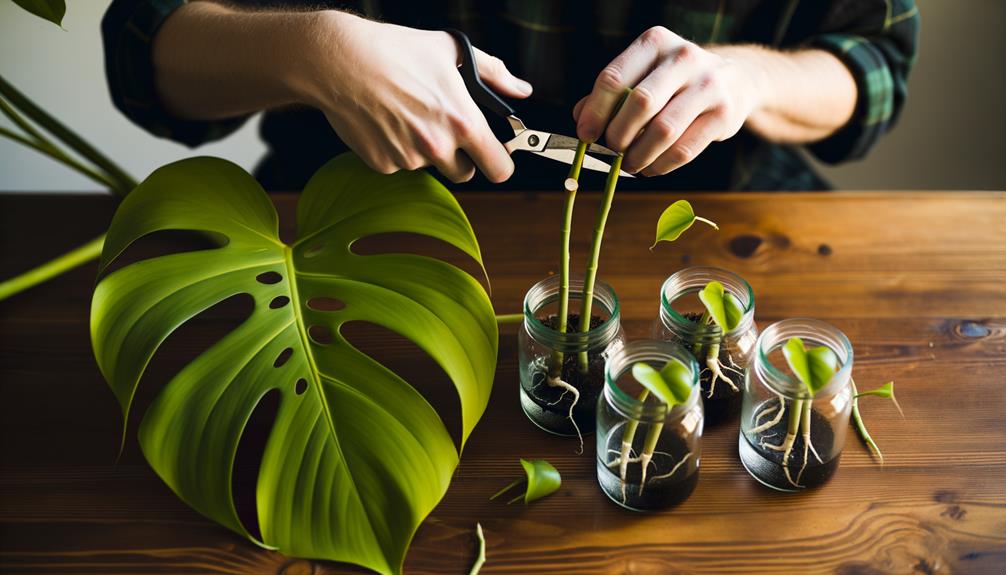
Key Takeaways
- Prune Monstera in early spring or summer to ensure maximum recovery and new growth.
- Use sharp, sterilized pruning shears and cut just above a node at a 45-degree angle.
- Select a 4-6 inch cutting with at least one node and aerial root for propagation.
- Propagate cuttings in water or well-draining soil, keeping the node submerged or soil moist.
- Place cuttings in bright, indirect light and maintain humidity levels between 60-70%.
Tools You Will Need
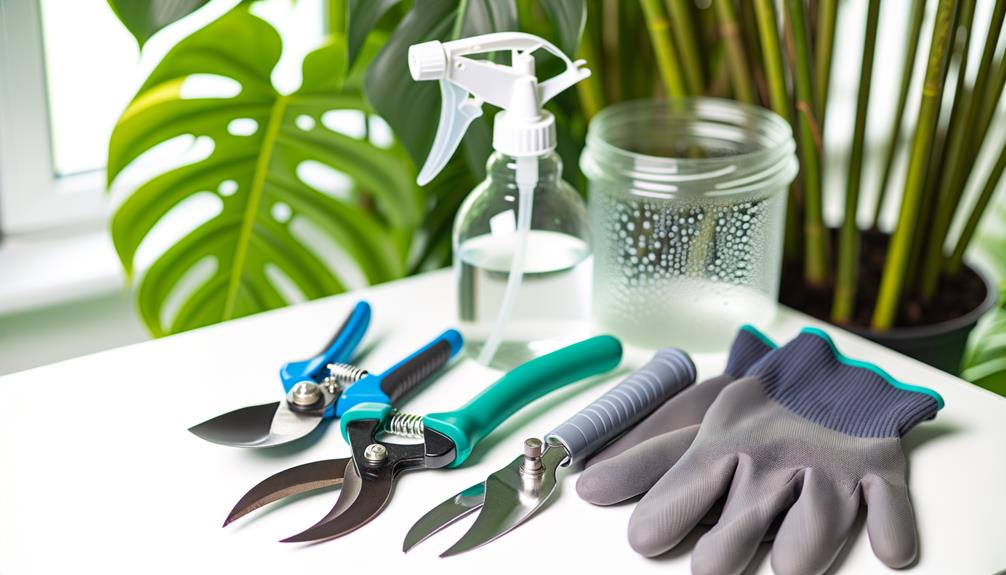
To effectively prune and propagate your Monstera, you’ll need a well-equipped toolkit that includes sharp pruning shears, a clean cutting board, and rooting hormone. Start by selecting high-quality pruning shears to guarantee clean cuts, reducing the risk of plant damage or infection.
A clean cutting board is essential to provide a sterile surface for preparing cuttings. Rooting hormone will enhance faster and more robust root growth, increasing the success rate of your propagation efforts.
Additionally, consider having a pair of gloves, disinfectant wipes, and small pots filled with a well-draining potting mix. These extra tools will help maintain plant health and cleanliness during the process, securing that your Monstera thrives.
Keep your tools sanitized to avoid contaminating your plant.
When to Prune
Prune your Monstera in early spring or summer when the plant is actively growing to guarantee maximum recovery and new growth. During this period, your Monstera will leverage its natural growth cycle for faster healing and enhanced vitality.
Pruning at the right time is essential for maintaining the plant’s health and appearance.
Consider the following:
- New Growth: Look for new leaves and aerial roots, indicators of an active growth phase.
- Weather Conditions: Secure consistent temperatures and adequate humidity to avoid stress.
- Daylight Hours: Longer daylight supports photosynthesis, aiding recovery.
- Current Health: Ensure your Monstera is free from pests or diseases before pruning.
How to Prune

Start by sterilizing your pruning tools with rubbing alcohol to prevent the spread of bacteria or disease.
Locate the nodes on your Monstera, which are the points where leaves and aerial roots emerge. Cut just above a node, using a sharp, clean pair of shears or scissors. Make sure to prune any yellowing or damaged leaves first, as these can sap energy from the plant.
For overgrown vines, trim back to control the shape and size of your Monstera. Always cut at a 45-degree angle to encourage faster healing and growth.
After pruning, water your plant thoroughly and give it time to recover in a well-lit area. Regular pruning promotes a healthier, more vigorous Monstera.
Propagation Techniques
After pruning your Monstera, you can use the healthy cuttings to propagate new plants, ensuring you have more lush greenery to enjoy.
Here are the steps you’ll need to follow:
- Select a Node: Choose a cutting with at least one node and aerial root. Nodes are critical as they’re the origin points for new growth.
- Prepare the Cutting: Trim the cutting just below the node, ensuring it’s around 4-6 inches long.
- Water Propagation: Place the cut end in a glass of water, ensuring the node is submerged. Change the water weekly.
- Soil Propagation: Alternatively, plant the cutting in well-draining soil, keeping the soil moist but not waterlogged.
Post-Care Tips
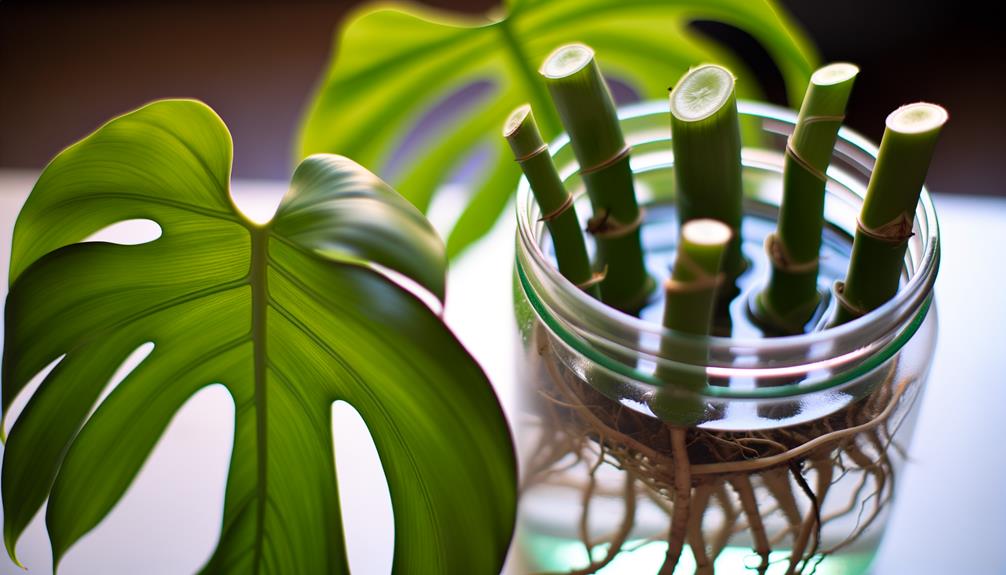
Optimizing your newly propagated Monstera cuttings thrive involves providing ideal lighting, maintaining humidity, and carefully monitoring soil moisture levels. Place the cuttings in bright, indirect light to encourage robust growth. Avoid direct sunlight, as it can scorch the delicate leaves.
To keep humidity levels at their best, consider using a humidity tray or a misting routine. Aim for a humidity level between 60-70%.
Soil moisture is essential; keep it consistently moist but not waterlogged. Use a well-draining potting mix to prevent root rot. Regularly check the soil with your finger; if the top inch feels dry, it’s time to water.
Fertilize monthly with a balanced, water-soluble fertilizer to provide essential nutrients. Following these steps leads to healthy, vigorous Monstera growth.
Conclusion
By mastering pruning and propagation techniques, you’ll transform your Monstera into a lush, vibrant centerpiece. Picture the glossy leaves unfurling, each one a proof of your care. With the right tools and timing, you’ve secured its health and essentiality.
Propagation will let you share this green beauty, multiplying the joy it brings. Remember, attentive post-care will keep your plant thriving. Your Monstera, thriving under your touch, will be a living work of art.

